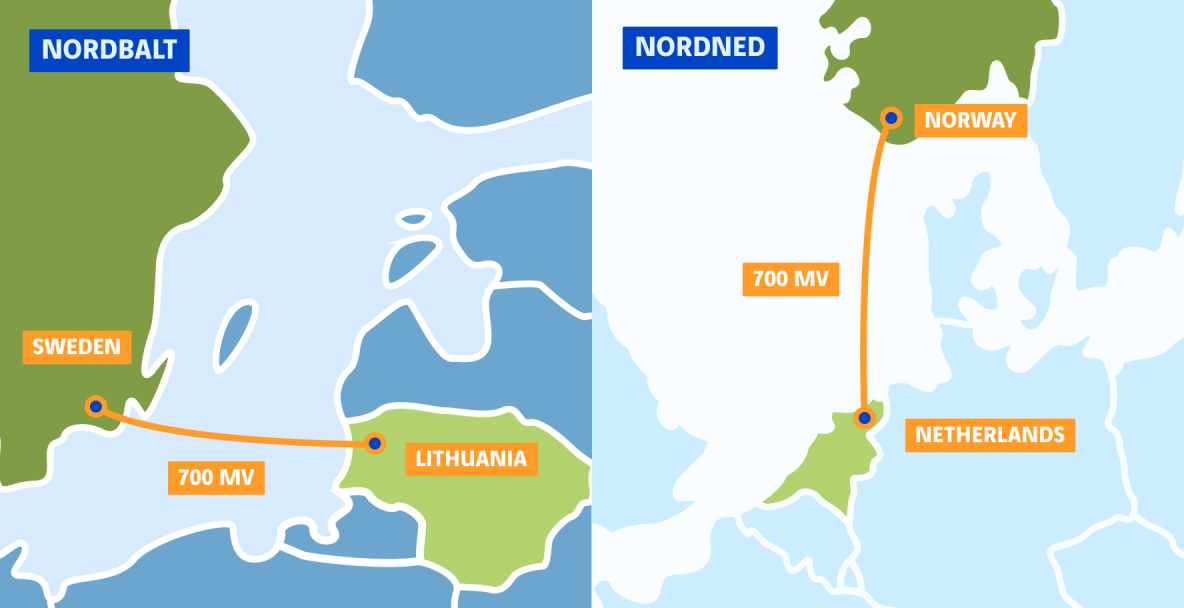
Subsea interconnectors: electricity supplies without borders
Faced with the uncertainties shrouding the global geopolitical arena, nations are scrambling for solutions to safeguard their energy sovereignty and futureproof their infrastructures. In this respect, subsea cross-border interconnectors act as vital arteries for distributing energy. Time for a deeper look at these gargantuan technological, economic and political projects driving the energy transition.
Unhindered electricity?
Subsea interconnectors help stabilise the power grid while optimising the use of renewable energy sources, which explains why they have come to play such a key role in energy infrastructures. These cables run across the sea or ocean floor and are capable of withstanding extreme pressure and hostile environments. Interconnectors are a true feat of engineering and are designed to carry electricity over distances of up to several hundreds of kilometres to deliver a continuous stream of energy between countries through onshore converter stations.
Guaranteeing energy security and integratring renewable energies
The valuable role played by subsea interconnectors can be attributed to growing pressure to improve energy security and diversify our energy sources. In Europe, this need was recently brought into sharper focus when the war in Ukraine1 broke out.
As part of the effort to move the energy transition forward, interconnections address a number of major challenges:
Interconnected power grids:
By connecting grids in different countries, these cables provide an easier way of exchanging electricity, which can help offset any temporary shortages, absorb spikes in demand and improve how available energy resources are used.
Integrating renewable energies:
Some renewable energy sources, such as wind and solar power, are intermittent by nature. Subsea interconnectors can carry the energy generated in areas where conditions are ideal for producing intermittent renewable energies to regions where energy demand levels are higher, which improves the integration of these energy sources into the global energy mix.
Windfarms and solar power plants may be very far from where their electricity is actually used. Although the power produced is irregular, there must be a quick way to transport the massive quantity of electricity.
Arnaud Gautier, Business Unit Manager at Omexom Major Projects, a VINCI Energies subsidiary.
Reducing the carbon footprint of the global energy mix
By facilitating renewable energy exchanges across borders, these interconnectors contribute directly to reducing greenhouse gas emissions by replacing the energy generated from fossil fuels with power produced from cleaner alternatives.
A power grid that is destined to grow
With over 300, 000 kilometres of high-voltage power transmission lines and 400 interconnectors, Europe boasts one of the most developed grids in the world. It provides over 600 million inhabitants with access to electricity2. The NordBalt cable between Sweden and Lithuania, and the NorNed cable between Norway and the Netherlands each feature a capacity of 700 MW. The IFA 2 interconnector between France and the UK has a capacity of 1 GW, which is equivalent to 500, 000 permanently powered homes, or the power of a nuclear reactor. All these cables are helping improve the effectiveness of the energy market in Europe.

Transporting energy: from DC to AC
To avoid energy losses, subsea cables carry direct current at very high voltages. Once it arrives at destination, it needs to be transformed into alternating current before it can be injected into the onshore grid for subsequent distribution. Between 2018 and 2020, the teams at VINCI Energies and VINCI Construction took part in the project to create the new subsea interconnector between France and the UK (called IFA 2) by building France’s converter station.
Other projects are springing up just about everywhere around the world. North America is a prime example, where some 200, 000 miles of lines (approximately 322, 000 km) and 35 interconnectors have been deployed between the United States and Canada3. In Asia, the ambitious Asian Super Grid project is currently being studied for connecting such countries as China, South Korea, India, Japan, Mongolia and Russia4 and building on their existing interconnectors. In Africa, the potential project for connecting North Africa to Europe through Trans-Saharan cables would be a major asset for reinforcing energy inclusion.
INELFE: a new strategic electricity interconnector between France and Spain
Electricity Interconnection France-Spain (INELFE) is the culmination of a joint effort between VINCI Energies, VINCI Construction, HITACHI Energy, Red Eléctrica and RTE to connect both countries through the Bay of Biscay.
This large-scale project is expected to be finalised by 2028. The project is aimed at rolling out 400 km of underground and submarine cables, and building two converter stations at both ends. Standing as the largest direct current interconnector in Europe, it will deliver a combined capacity of 2, 000 MW between France and Spain, which is equivalent to the energy used by 2 million homes (e.g. the city of Paris).
Subsea interconnectors are fully in keeping with the strategic vision of forging a sustainable and networked energy future. By overcoming physical and geopolitical challenges, they lay the foundations for greater cross-border energy cooperation, which is essential for combating climate change and reinforcing energy security in the future.
Most viewed
Vous aimerez aussi
Words from researchers: let's fight stereotypes!
Charlotte, a research fellow at École des Mines, and Erwan, a university professor and researcher at AgroParisTech, talk…
Fondation VINCI pour la Cité: opening the door to others is another way of reaching out!
With some 1.3 million organisations and 2 million employees, France can lay claim to a dynamic network of associations…
Sea water desalination: a solution for turning the tide on the water scarcity crisis?
As water shortages continue causing havoc in a growing number of regions around the world, an age-old idea is experiencing a…








